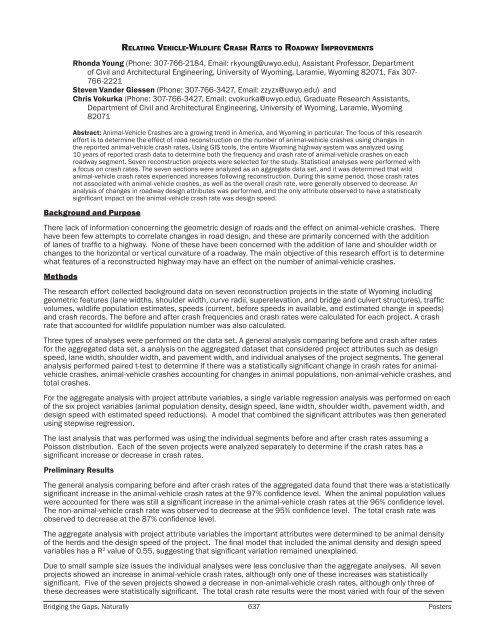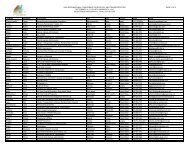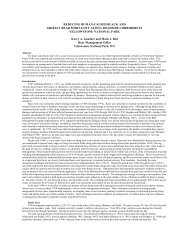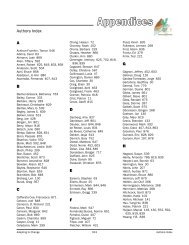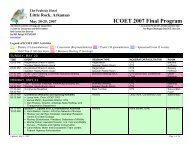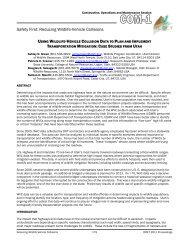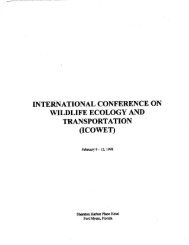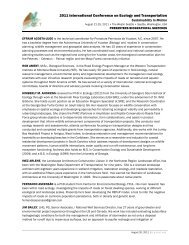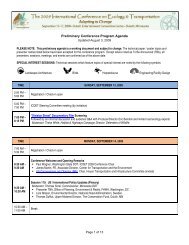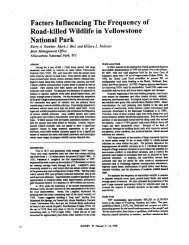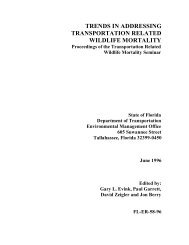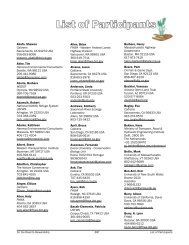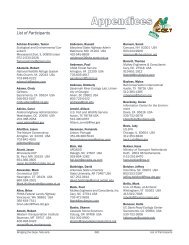Poster Sessions, pages 567-640 - ICOET
Poster Sessions, pages 567-640 - ICOET
Poster Sessions, pages 567-640 - ICOET
Create successful ePaper yourself
Turn your PDF publications into a flip-book with our unique Google optimized e-Paper software.
Relating Vehicle-Wildlife Crash Rates to Roadway Improvements<br />
Rhonda Young (Phone: 307-766-2184, Email: rkyoung@uwyo.edu), Assistant Professor, Department<br />
of Civil and Architectural Engineering, University of Wyoming, Laramie, Wyoming 82071, Fax 307-<br />
766-2221<br />
Steven Vander Giessen (Phone: 307-766-3427, Email: zzyzx@uwyo.edu) and<br />
Chris Vokurka (Phone: 307-766-3427, Email: cvokurka@uwyo.edu), Graduate Research Assistants,<br />
Department of Civil and Architectural Engineering, University of Wyoming, Laramie, Wyoming<br />
82071<br />
Abstract: Animal-Vehicle Crashes are a growing trend in America, and Wyoming in particular. The focus of this research<br />
effort is to determine the effect of road reconstruction on the number of animal-vehicle crashes using changes in<br />
the reported animal-vehicle crash rates. Using GIS tools, the entire Wyoming highway system was analyzed using<br />
10 years of reported crash data to determine both the frequency and crash rate of animal-vehicle crashes on each<br />
roadway segment. Seven reconstruction projects were selected for the study. Statistical analyses were performed with<br />
a focus on crash rates. The seven sections were analyzed as an aggregate data set, and it was determined that wild<br />
animal-vehicle crash rates experienced increases following reconstruction. During this same period, those crash rates<br />
not associated with animal-vehicle crashes, as well as the overall crash rate, were generally observed to decrease. An<br />
analysis of changes in roadway design attributes was performed, and the only attribute observed to have a statistically<br />
significant impact on the animal-vehicle crash rate was design speed.<br />
Background and Purpose<br />
There lack of information concerning the geometric design of roads and the effect on animal-vehicle crashes. There<br />
have been few attempts to correlate changes in road design, and these are primarily concerned with the addition<br />
of lanes of traffic to a highway. None of these have been concerned with the addition of lane and shoulder width or<br />
changes to the horizontal or vertical curvature of a roadway. The main objective of this research effort is to determine<br />
what features of a reconstructed highway may have an effect on the number of animal-vehicle crashes.<br />
Methods<br />
The research effort collected background data on seven reconstruction projects in the state of Wyoming including<br />
geometric features (lane widths, shoulder width, curve radii, superelevation, and bridge and culvert structures), traffic<br />
volumes, wildlife population estimates, speeds (current, before speeds in available, and estimated change in speeds)<br />
and crash records. The before and after crash frequencies and crash rates were calculated for each project. A crash<br />
rate that accounted for wildlife population number was also calculated.<br />
Three types of analyses were performed on the data set. A general analysis comparing before and crash after rates<br />
for the aggregated data set, a analysis on the aggregated dataset that considered project attributes such as design<br />
speed, lane width, shoulder width, and pavement width, and individual analyses of the project segments. The general<br />
analysis performed paired t-test to determine if there was a statistically significant change in crash rates for animalvehicle<br />
crashes, animal-vehicle crashes accounting for changes in animal populations, non-animal-vehicle crashes, and<br />
total crashes.<br />
For the aggregate analysis with project attribute variables, a single variable regression analysis was performed on each<br />
of the six project variables (animal population density, design speed, lane width, shoulder width, pavement width, and<br />
design speed with estimated speed reductions). A model that combined the significant attributes was then generated<br />
using stepwise regression.<br />
The last analysis that was performed was using the individual segments before and after crash rates assuming a<br />
Poisson distribution. Each of the seven projects were analyzed separately to determine if the crash rates has a<br />
significant increase or decrease in crash rates.<br />
Preliminary Results<br />
The general analysis comparing before and after crash rates of the aggregated data found that there was a statistically<br />
significant increase in the animal-vehicle crash rates at the 97% confidence level. When the animal population values<br />
were accounted for there was still a significant increase in the animal-vehicle crash rates at the 96% confidence level.<br />
The non-animal-vehicle crash rate was observed to decrease at the 95% confidence level. The total crash rate was<br />
observed to decrease at the 87% confidence level.<br />
The aggregate analysis with project attribute variables the important attributes were determined to be animal density<br />
of the herds and the design speed of the project. The final model that included the animal density and design speed<br />
variables has a R 2 value of 0.55, suggesting that significant variation remained unexplained.<br />
Due to small sample size issues the individual analyses were less conclusive than the aggregate analyses. All seven<br />
projects showed an increase in animal-vehicle crash rates, although only one of these increases was statistically<br />
significant. Five of the seven projects showed a decrease in non-animal-vehicle crash rates, although only three of<br />
these decreases were statistically significant. The total crash rate results were the most varied with four of the seven<br />
Bridging the Gaps, Naturally 637 <strong>Poster</strong>s


